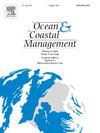粤东沿海地区粪便污染源及关键环境参数与抗生素耐药基因的关系
IF 5.4
2区 环境科学与生态学
Q1 OCEANOGRAPHY
引用次数: 0
摘要
沿海生态系统中的抗生素耐药基因(ARGs)对环境和人类健康构成重大威胁。因此,准确查明ARGs的来源对于实施有针对性的缓解战略至关重要。本研究采用定量聚合酶链反应对两次采样活动(2021年9月和12月)在中国广东东部沿海水域采集的海水和沉积物样本进行了分析。目的是研究ARGs、微生物源追踪(MST)标记和理化驱动因素的时空动态。ARGs (sul1, sul2, tetW, ermF, mcr-1, blaTEM, blaNDM-1)几乎无处不在(84% - 100%),其中磺胺抗性基因(sul1, sul2)在海水中占主导地位,而ermF和tetW在沉积物中占主导地位。与人类相关的MST标记(BacHum和CPQ_056)在海水中表现出明显的季节性增加,这反过来又与ARGs丰度密切相关。主成分分析显示,冬季人类粪便污染加剧导致MST分布存在时间分层。营养物(NH3-N和PO43−)和藻类生物量(Chl-a)是冬季的关键因子,而氧和pH在夏季占主导地位。沉积物是ARGs的重要储集层,沉积物中ermF和tetW的浓度是海水中的2-3倍。整合酶基因intI1与sul1和sul2一致共存,表明水平基因转移(HGT)可能是该地区抗生素耐药性传播的重要机制。相关试验和Mantel试验证实,人类粪便输入是沿海地区ARGs的主要来源。尽管反刍动物相关标记物的贡献很小,但家禽相关标记物GFD表现出持续的低水平存在,而猪相关标记物p.d 5在沉积物中表现出局部持久性。这些发现强调了将微生物源跟踪纳入沿海管理框架的紧迫性,未来的研究需要评估缓解战略的长期效力,并评估其在全球人为压力海洋生态系统中的可扩展性。本文章由计算机程序翻译,如有差异,请以英文原文为准。
Association of antibiotic resistance genes with fecal pollution sources and key environmental parameters in the coastal waters of eastern Guangdong, China
Antibiotic resistance genes (ARGs) in coastal ecosystems pose substantial threats to both environmental and human health. Thus, accurately identifying the sources of ARGs is critical for implementing targeted mitigation strategies. This study employed quantitative polymerase chain reaction to analyze seawater and sediment samples collected from the eastern coastal waters of Guangdong, China, during two sampling campaigns (September and December 2021). The aim was to investigate the spatiotemporal dynamics of ARGs, microbial source tracking (MST) markers, and physicochemical drivers. ARGs (sul1, sul2, tetW, ermF, mcr-1, blaTEM, blaNDM-1) exhibited near-ubiquitous detection (84 %–100 %), with sulfonamide resistance genes (sul1, sul2) dominating in seawater, while ermF and tetW dominated in sediments. Human-associated MST markers (BacHum and CPQ_056) demonstrated pronounced seasonal increases in seawater, which in turn was closely related to ARGs abundance. Principal component analysis revealed a temporal stratification of MST profiles attributed to intensified human fecal pollution in winter. Nutrients (NH3-N and PO43−) and algal biomass (Chl-a) were identified as the key factors in winter, in contrast to the dominance of oxygen and pH in summer. Sediments played a crucial role as reservoirs for ARGs, with the sediment concentrations of ermF and tetW being 2–3 times those in seawater. The integrase gene intI1 consistently co-occurred with sul1 and sul2, which indicated that horizontal gene transfer (HGT) might serve as an important mechanism for disseminating antibiotic resistance in this region. Correlation and Mantel tests confirmed that human fecal inputs were the primary source of ARGs in the coastal area. Despite minimal contributions from ruminant-associated markers, the poultry-associated marker GFD exhibited persistent low-level presence, while the swine-associated marker P.ND5 demonstrated localized persistence in sediments. These findings underscore the urgency of integrating microbial source tracking into coastal management frameworks, with future research needed to evaluate the long-term efficacy of mitigation strategies and assess their scalability across anthropogenically stressed marine ecosystems worldwide.
求助全文
通过发布文献求助,成功后即可免费获取论文全文。
去求助
来源期刊

Ocean & Coastal Management
环境科学-海洋学
CiteScore
8.50
自引率
15.20%
发文量
321
审稿时长
60 days
期刊介绍:
Ocean & Coastal Management is the leading international journal dedicated to the study of all aspects of ocean and coastal management from the global to local levels.
We publish rigorously peer-reviewed manuscripts from all disciplines, and inter-/trans-disciplinary and co-designed research, but all submissions must make clear the relevance to management and/or governance issues relevant to the sustainable development and conservation of oceans and coasts.
Comparative studies (from sub-national to trans-national cases, and other management / policy arenas) are encouraged, as are studies that critically assess current management practices and governance approaches. Submissions involving robust analysis, development of theory, and improvement of management practice are especially welcome.
 求助内容:
求助内容: 应助结果提醒方式:
应助结果提醒方式:


